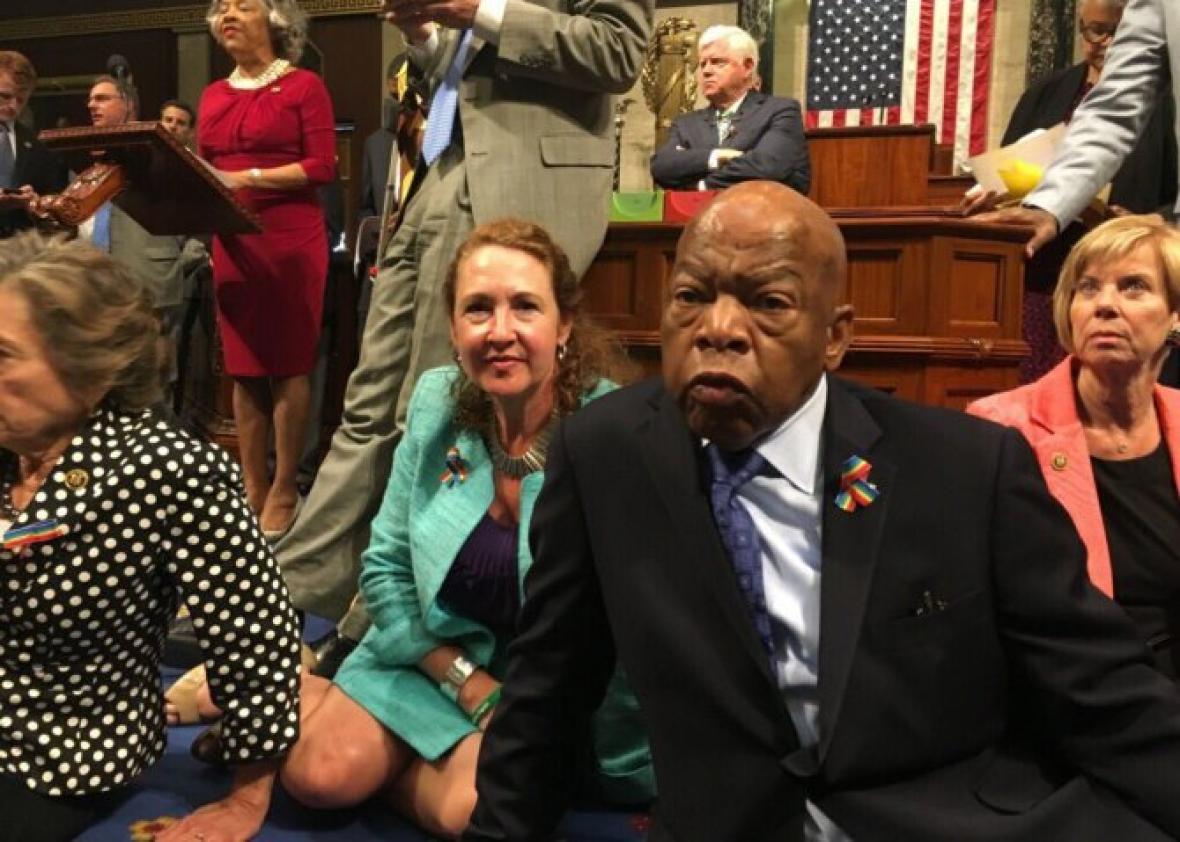Also in Slate, read our coverage of the sit-in as it happened. The GOP still tried to scrap tighter restrictions on financial advisers during the protest Wednesday night. And, ironically, Rep. John Lewis was once on the no-fly list himself.
On Wednesday, a group of Democrats took over the floor of the House of Representatives in protest of Republican stasis on new gun control proposals. Chanting “no bill, no vote,” these lawmakers blocked Speaker Paul Ryan and the House GOP from a full day of regular business. And so far, they’ve attracted support from dozens of other Democratic lawmakers, including Senate Minority Leader Harry Reid and Vermont Sen. Bernie Sanders. “We’ll be here as long as it takes, every day,” said House Minority Leader Nancy Pelosi of the so-called sit-in. “This is the moment of truth.” Republicans have turned off House-controlled cameras and microphones, forcing Democrats (and C-SPAN) to rely on social media and streaming video. Leading the charge is Rep. John Lewis, who brings his stature as a civil rights hero, lending the protest some of his civil disobedience bona fides. “We’re going to continue to sit in and sit down,” he said Wednesday evening. “By sitting in and sitting down, we’re standing up.”
Everything about this is controversial. Republicans see it as little more than a “stunt” aimed at curtailing constitutional rights. Meanwhile, civil libertarians are dismayed that Democrats want to use the much-criticized terror watch list—marred by bias and rendered suspect by a lack of due process—to limit gun ownership. And some liberals are worried that this only escalates political conflict. “How will Dems cheering the sit-in react if a year from tonight it’s House Republicans sitting in to block President Clinton’s agenda,” said MSNBC’s Steve Kornacki on Twitter. He continued: “Dems talk about an anti-Trump wave giving HRC a Dem House to work with. Now here’s a tactic R’s could use if they’re back in the minority.”
That this action is controversial shouldn’t obscure the degree to which it’s also remarkable. But not because of the form. Congressional sit-ins are unusual, but they aren’t unheard of. “In 2008,” notes the New York Times, “House Republicans, then in the minority, held a ‘quasi session’ during summer recess to protest the Democrats’ refusal to hold votes on energy policy amid sharply rising gasoline prices.” If there’s a difference, it’s that the GOP protest wasn’t disruptive, as the House was in recess. In that regard, Democrats are indeed doing something unprecedented.
But more important for us, as observers, is that all of this is over gun control, and it’s happening with almost unanimous support from congressional Democratic leaders. This wouldn’t have happened 10 years ago, and for good reason. The Democratic majority of 2007–08—and even 2009–10—was more liberal than previous majorities, but it still spanned wide divides of geography and ideology. Conservative and center-right “Blue Dog” Democrats were still an important element of the party’s support, and they had a voice in Congress. A public protest for gun control would have been near-suicidal for those members.
But then came the 2010 and 2014 midterm elections (and the subsequent redistricting), and suddenly, the Democratic Party was purged of its most conservative members. There’s no doubt Pelosi wants a majority, but while she’s in the minority, neither she nor her caucus has to cater to vulnerable Democrats in the rural South or West. The kinds of voters Democrats once tried to attract by shying away from gun politics are Republicans now. And Democrats don’t believe they need to reach out to them. The politics, they argue, have turned.
That Democrats are willing to gum up the House in an effort to pass new gun control legislation is indicative of the change in the congressional Democratic Party over the past seven years. It’s a geographically smaller party, with many more liberals and a proportionately greater number of representatives from dense urban areas. Where once it counted NRA backers like Michigan’s John Dingell among its longest-serving members, now it’s dominated by liberals like Lewis, with few if any ties to pro-gun activists. It’s almost tailor-made for a vocal action on gun control. Couple that with broad support for new anti-gun measures among Democratic voters, and you get the spectacle of the past seven days, which included a filibuster in addition to Wednesday’s sit-in. Regardless of where you stand on the issue itself, this past week is the clearest possible evidence that we’re watching a new kind of Democratic Party, one in which a young black representative from Brooklyn named Hakeem Jeffries, speaking shortly before midnight, invokes Martin Luther King and Bull Connor in a call-and-response with his colleagues. One that’s changing.
